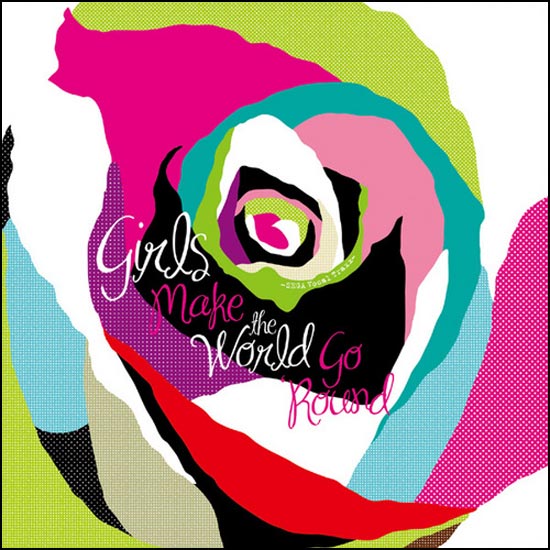This one’s a bit of an oddity. I saw it on a release calendar, and wasn’t sure what to make of it. I thought for sure that it must be a collection of vocal themes from Sonic games and the like, but as it turns out, Girls Make the World Go ‘Round -SEGA Vocal Traxx- is a completely original album of vocal themes created by the sound team at SEGA.
So, just who’s involved? I can’t say that any of the vocalists are familiar, but the music is composed by Sonic series composer Tomoya Ohtani, Mariko Nanba, and others at SEGA. Similar to their work on Sonic World Adventure and Sonic Colors, the album also gets the live music treatment, so see if their experiment pays off after the jump!
The album features 11 tracks tracks from 8 different vocalists. As mentioned, live players are featured prominently, from small string sections to individual guitarists, pianists, brass players, and more. The song selection is pretty eclectic, covering everything from pop ballads to rock to electronic, but it’s all pretty upbeat.
Unfortunately, some of the first few tracks on the album are the weakest, and nearly turned me off to the entire project. The opener, “Just Beyond the Rainbow,” takes on a tropical island vibe with some nice xylophone chords and a deep bass line, but the vocals by Emily McEwan are delivered in such a plastic manner that it makes it difficult to enjoy the track. The carnival-like atmosphere of “Spin the Wheel” is also marred by mediocre vocals by Inara George, although I can’t say the brassy and incredibly cheery backing is really my thing either.
From here things get more interesting, however. Artist marhy provides her soft and dreamy voice to four tracks on the album. She takes on a soft and sweet sound that reminds me of SAWA in “Spiritual Journey” and “It’s Too Good to be True,” with the former coming with guitar wahs and dreamy pads and strings, and the latter with a funky disco backing. “Appreciate” and “Joy,” on the other hand, feature marhy in vocaloid-like form, with “Joy” being one of my favorite tracks on the album. It gets a funky electronic bass alongside twinkling synth lines that are downright catchy, providing a perfect electronic foundation for marhy’s voice.
“Crystal Sea” by Mariko Nanba with vocals by arlie is another favorite of mine. I feel as though I shouldn’t like it as much as I do as arlie’s voice has that really soft, drawn-out ‘Engrishy’ kind of voice, but I guess it works so well with the electronic/orchestral pop hybrid backing that I can’t help but love it. There’s a driving electronic bass with rich strings that sound like they’re borrowed from Yuki Kajiura’s work on Xenosaga. It’s fantastic, and the chorus section is beautiful.
“Sakurasaku” by vocalist 一十三十一 takes a fun Asian disco turn with a funky slap bass and Rhodes piano along with a bendy string section and vocal melody. After hearing Ohtani’s Asian-influenced tracks on recent Sonic soundtracks, this one doesn’t surprise me at all, and it’s very well done. “Emmène-Moi Au Futur,” on the other hand, is sung in French by vocalist YELLE. It’s poppy and sweet, and I can imagine the vocals will grate on the nerves of some, but I love the silly and playful sound. Weird synth lines and pads abound around every turn, and this one will certainly put you in a good mood. “The Guiding Star” is the only track on the album I like featuring a native English speaker, this time Patty Gaddum. The lyrics are admittedly cheesy, being incredibly light and ‘inspirational,’ but I dig the dreamy techno backing.
There is, however, one more stinker found at the end of the album. “Lava Rock” with vocals by Skye Sweetnam brings in that cheesy pop rock sound that ruined some past Sonic titles for me. The vocals have a certain teen pop idol quality about them, and it’s obvious that the singer is trying hard to be ‘cool’ even though she knows she can’t sing these lyrics with a straight face: “It doesn’t matter if you don’t know the move, no one will laugh at you, just be yourself… it costs you lotta sweat, I mean lotta sweat.” It’s a shame because the music is actually pretty good. I think a total rewrite of the vocals and a new, more inspired vocalist could have turned this one around.
Overall, I’d say that this experiment provides a pretty mixed result. I like about half of the tracks, with several of those being quite amazing. I suppose if you consider a pop album, liking half of the tracks is a pretty good sign. Unfortunately the ones that are bad are so bad that I’d probably never want to play the album in its entirety with people around. Yes, it’s that embarrassing.
Still, I like the album and its concept. All of the music here is great even if some of the vocalists aren’t. The music is well produced, and I love that they included live players. The packaging isn’t much to look at, but it’s actually pretty unique. The album (which appears with a textured vinyl print) comes in a thick cardboard case that is covered in colorful artwork. A fold-out poster inside has all of the song lyrics and credits, and there’s even a cute little obi that is super thin to accommodate the sleeve.
It’s still available at CD Japan and Play-Asia if you’re interested in checking it out. If you’re into vocal themes and pop music, it may be right up your alley.
What do you think of SEGA’s experiment? Would you like to see more game-oriented record labels releasing original albums like this?
Tags: Girls, Mariko Nanba, Music Reviews, Reviews, SEGA, Tomoya Ohtani, Vocals, Wave Master









































This isn’t original, you know.
It’s the vocal tracks from Super Monkey Ball: Step and Roll by SEGA.
Hm, in fact, I didn’t know. I don’t think anybody did. Nobody must have played the game! Wonder why they didn’t call it the Super Monkey Ball: Step and Roll soundtrack.